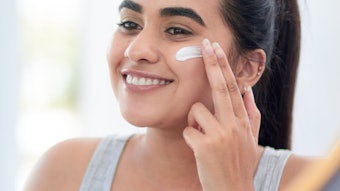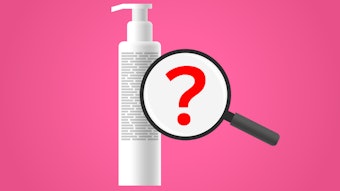
As our knowledge of the sun’s impact on our skin—specifically the ever-increasing concerns about skin damage and wrinkling, and more importantly global increases in skin cancers—has grown in the past 30 years, scientists have been driven to provide products with much greater sun protection. From the early sun protection factor (SPF) 15 products, we now routinely see products with SPF 50-plus.
During this time we have also made enormous achievements broadening the UV absorption capabilities to eliminate much of the UVA spectral range. Further, the US hopes to introduce additional superior sunscreen actives to the market via the Sunscreen Innovation Act. If at any time we feel complacent about this critical class of products, new research emerges that challenges our perceptions of sunscreens and human health outcomes.
Sunscreen and Vitamin D Synthesis
As sunscreen science has advanced, an ongoing dialogue about vitamin D deficiency and its reported health impacts has emerged. It is well-recognized that Vitamin D deficiency affects approximately 40% of children and 60% of adults.1 Without this vitamin, it is very difficult for the body to absorb calcium and phosphate, integral components of our body’s bones and teeth.
While it is possible to get Vitamin D from several types of foods, including fish, liver and milk, very little is absorbed through the diet. The principle human source of vitamin D is sun-synthesized.2
Lack of Vitamin D is related to a variety of health issues including musculoskeletal problems, some forms of cancer, autoimmune diseases and neurocognitive disorders.3 The National Osteoporosis Foundation recommends that all adults should have 400 to 800 International units (IU) of Vitamin D per day; those over 50 years of age need approximately 1,000 IU per day.4
The amount of vitamin D that a person can synthesize from exposure to sunlight depends on several factors, including where and when a person exposes their skin, air pollution, altitude and cloud cover, among others. However, these same factors inversely affect the risk for sunburn and skin cancers. It is theoretically possible to have too much Vitamin D, but it is rare and would normally happen only from excessive vitamin supplementation, not from diet or sun exposure alone.5
Vitamin D deficiency is a much more common occurrence, due to limited sun exposure in northern and southern latitudes and fear of developing skin cancers. The primary strategies used to mitigate the risk of skin cancers are avoiding sun exposure, wearing appropriate clothing and applying sunscreen. Using a sunscreen with a sun protection factor of 30 reduces UV exposure by nearly 97%.6 It would make sense theoretically that this also has the potential to reduce the skin’s capacity to produce vitamin D.
The Battle Between Adequate Vitamin D Production
and Cancer Risk
The debate that has ensued over the years has examined the risk-benefit ratio of sunscreen use. Regarding the benefit, researchers have examined the actual reduction in skin cancers from the use of sunscreen. Data has proven that squamous cell cancers are reduced by approximately 51% from the appropriate use of sunscreen.7 However, “a statistically significant protective benefit of sunscreen has not been demonstrated against either basal cell carcinoma or malignant melanoma.” 7
The issues with these studies is that many date back to 1970s and 1980s and no doubt involved sunscreens with lower SPF values than are typical today, as well as without the broad-spectrum (UVA and UVB) coverage which is typical in sunscreens presently available.7 It is possible that with better SPF technology, future studies may demonstrate that sunscreens may have a preventative effect on all forms of skin cancers.
At the same time, researchers have considered the possibility that sunscreens could reduce vitamin D status and contribute to a variety of adverse human health outcomes. Real-world studies, however, do not bear this out.8 Again, this could be related to the types of sunscreens used in the studies, and it may also be due to the established fact that consumers dramatically under use sunscreens.
The recommended dose of sunscreen is 2 mg/cm²; in reality, researchers have observed dosing more in the range of 0.39 to 1.5 mg/cm².7 This begs the question: Have studies showing no compromise of vitamin D status been the result of the types of sunscreens used and under dosing? One study showed sufficient but less vitamin D was produced when proper dosing was observed, but this was done in a high-sun environment.9 This is worth consideration, particularly in low-sun environments with special groups such as children and pregnant women, as Vitamin D is critical to the formation and maintenance of strong bones—particularly during development. Pregnant women with low levels of vitamin D will not pass on enough of this crucial vitamin to their babies in utero.
Sunscreen Facilitating Vitamin D Synthesis
A recent paper reveals research into the thought-provoking concept of designing a sunscreen that maximizes vitamin D synthesis in skin.10 Researchers at Boston University in Massachusetts developed a product they refer to as “Solar D,” which they found offered the same protection as SPF 30 sunscreens while allowing up to 50% more protection of Vitamin D in-vitro.10 They designed four in-vitro tests to measure the levels of protection and Vitamin D optimization for these sunscreens, with human trials expected to follow.
One of the investigators, Michael F. Holick, PhD, professor of medicine, physiology and biophysics at Boston University School of Medicine, stated, “The ingredients in the sunscreen are essentially identical to most of the major brands, with the minor adjustment of the formulation to enhance the transmission of ultraviolet light that specifically makes vitamin D3 in the skin.”11
Holick is renowned for his research in vitamin D and is a well-known advocate for additional supplementation of it, being the first to identify its major circulating form in human blood—known as 25-hydroxyvitamin D3.12 While debate over appropriate vitamin D levels continues, the suggestion that vitamin D deficiency is widespread is generally accepted.
In his recent publication, the active ingredients in the sunscreen tested along with their composition are listed in Table 1.13
Of the five actives found within Solar D, diethylamino hydroxybenzoyl hexyl benzoate is not FDA-approved, however, it is approved for use in Asia and the European Union.14 Due to the fact that Canada allows very similar active ingredients as the US, a sunscreen that contains this filter would not be able to be marketed in either country.15
According to Ernest Armstrong, head of product development for Solar D, the company has removed diethylamino hydroxybenzoyl hexyl benzoate from formulations marketed in the US and Canada. While the ingredient is currently included in the formulation on the market in Australia—where it is approved— according to Armstrong it will be removed because of its tendency to stain fabrics. While other active systems were not discussed in its recent publication, it indicates that all Solar D products permit enhanced Vitamin D production while passing SPF testing for label values of 15, 30 and 50.
According to Holick, “Solar D sunscreens permit the passage of some of the sunlight your skin uses naturally to make vitamin D.”11
According to these researchers, sunscreens protect the skin against erythemal radiation (Eer) while also reducing the effective radiation dose (EVD), which is responsible for the formation of pre vitamin D in the human body.10 This study discusses a way to optimize the EVD/Eer ratio behind sun protection factors of 5, 15 and 30. In-vitro experiments demonstrated that there was a significant increase of conversion from 7-dehydrocholesterol (7-DHC) to pre-vitamin D when borosilicate ampoules containing the 7-DHC were exposed to artificial UV solar radiation. This was realized when using experimental sunscreens that were optimized for producing Vitamin D compared to a commercially sold sunscreen with the same SPF. The explanation offered by these authors is that with judicious formulation, a sunscreen can be developed that will maximize the transmission of UV around 295 nm, the peak action spectrum for pro-vitamin D3 production.10
Conclusion
These various findings suggest that we have much more to learn about sun protection. For example:
- How can we design sunscreens to provide proper dosing? Clearly, consumers underutilize these vital products, dramatically reducing their effectiveness.
- Assuming proper dosing, what is the real-world impact of vitamin D status using today’s most effective sunscreens?
- What else can we learn about the creation of sunscreens to maximize vitamin D synthesis in the skin? Can we further tailor formulations to maximize the transmittance of critical wavelengths? Can the in-vitro results be borne out in-vivo?
- What are the regulatory implications for manufacturers claiming a vitamin D benefit with monographed sunscreens? Will North American regulators see these as new drug claims?
Finally, what is the correct way to regulate sunscreens as a category? This is a debate that has raged for decades and has no harmonized global answer. While there is a temptation to consider sunscreens simply as cosmetics, their implications for human health are truly considerable. Much remains to be learned about their role in mitigating skin cancers and their influence on vitamin D status.
References
- Wacker M. and Holick MF. Sunlight and Vitamin D: A global perspective for health. Dermatoendocrinol. 2013; 5(1), 51–108. doi: 10.4161/derm.24494. pmid:24494042
- Food Sources of Vitamin D. (2014, February 25). Retrieved February 18, 2016, from Dietitians of Canada: http://www.dietitians.ca/Your-Health/Nutrition-A-Z/Vitamins/Food-Sources-of-Vitamin-D.aspx
- Brazier, Y. (2016, February 4). “New sunscreen offers vitamin D production with UV protection.” Medical News Today. Retrieved from http://www.medicalnewstoday.com/articles/305956.php
- Calcium and Vitamin D: What You Need to Know. (n.d.). Retrieved February 18, 2016, from National Osteoporosis Foundation: http://nof.org/calcium#howmuchvitamind
- Am I getting too much Vitamin D? (n.d.). Retrieved February 18, 2016, from Vitamin D Council: http://www.vitamindcouncil.org/about-vitamin-d/am-i-getting-too-much-vitamin-d/
- Wang, S. Q. (n.d.). Does a higher-SPF sunscreen always protect your skin better. Retrieved February 18, 2016, from Skin Cancer Foundation: http://www.skincancer.org/skin-cancer-information/ask-the-experts/does-a-higher-spf-sunscreen-always-protect-your-skin-better
- Burnett, M. E. and Wang, S. Q. (2011), Current sunscreen controversies: a critical review. Photodermatology, Photoimmunology & Photomedicine, 27: 58–67. doi: 10.1111/j.1600-0781.2011.00557.x
- Matsuoka, L., Ide, L., Wortsman, J., MacLaughlin, J., & Holick, M. (1987, June). Sunscreens suppress cutaneous vitamin D3 synthesis. The Journal of Clinical Endocrinology and Metabolism, 64(6), 1165-8. Retrieved February 18, 2016, from http://www.ncbi.nlm.nih.gov/pubmed/3033008
- Pitman, S. (2013, June 11). New research suggests sunscreens do not significantly inhibit vitamin D synthesis. Retrieved March 7, 2016, from CosmeticsDesign - Europe: http://www.cosmeticsdesign-europe.com/Formulation-Science/New-research-suggests-sunscreens-do-not-significantly-inhibit-vitamin-D-synthesis
- Kockott D, Herzog B, Reichrath J, Keane K, Holick MF (2016) New Approach to Develop Optimized Sunscreens that Enable Cutaneous Vitamin D Formation with Minimal Erythema Risk. PLoS ONE 11(1): e0145509. doi:10.1371/journal.pone.0145509
- Boston University School of Medicine news release, accessed 2 February 2016.
- Holick, M. (2015). Dr. Michael Holick. Retrieved February 18, 2016, from Dr. Michael F. Holick: http://drholick.com/
- (2015). Retrieved February 18, 2016, from Solar D Sunscreen: http://solar-d.com.au/
- U.S. Food and Drug Administration. (2015, April 1). Code of Federal Regulations Title 21. Retrieved February 18, 2016, from U.S Department of Human Health Services: http://www.accessdata.fda.gov/scripts/cdrh/cfdocs/cfcfr/CFRSearch.cfm?CFRPart=352&showFR=1
- Health Canada. (2013, July 7). Sunscreen Monograph - Version 2.0. Retrieved February 18, 2016, from Health Canada: http://webprod.hc-sc.gc.ca/nhpid-bdipsn/atReq.do?atid=sunscreen-ecransolaire&lang=eng











